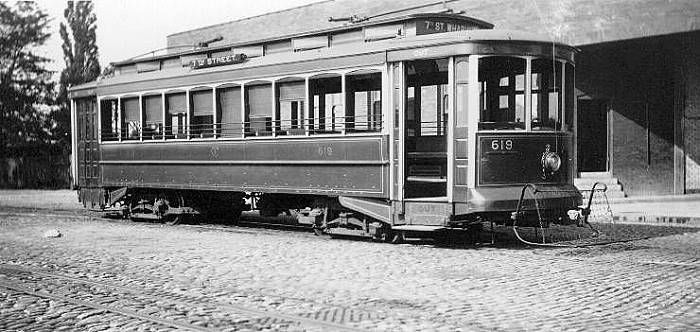
Sister car 619 at 7th Ave Care House Washington DC in 1912 by LeRoy King in Bill Volker Collection on newdavesrailpix.com
- Builder
- Jewett Car Co.
- Description
- Composite Closed City
- Secondary Use
- Camp
- Type
- City and Suburban Streetcars
- Year
- 1910
- Retired from Service
- 1938
- Acquired by the Museum
- 1989
- Fund
- 868
Capital Transit Co. 197
From Washington D.C.
History
In the early 20th Century, Capital Traction was one of two principal streetcar companies serving Washington, DC. Capital Traction’s operation included routes between Capital Hill and Georgetown and Chevy Chase, MD. In 1933, Capital Traction merged with the other principal streetcar company in Washington – the Washington Railway and Electric Company – to form Capital Transit Company. Washington, like a few other cities, banned “unsightly” overhead wires from its streets. Washington streetcars collected power from an underground vault between the running rails. Most of the streetcars, including No. 197, also had trolley poles for operation in the suburbs. In 1910-1912, Capital Traction purchased 150 deck roof cars, Nos. 601 – 750, from the Jewett Car Co. This group included No. 611, which was renumbered No. 197 when Capital Transit was formed. These cars provided the backbone of Capital Traction’s service for many years. No. 197 saw service on Pennsylvania Avenue between the Capitol and the White House. Capital Transit began buying PCC streetcars in 1937 and scrapped the Jewett cars in the 1940s.
In 1946 (some sources have 1938), No. 197 became a seaside summer camp on Maryland’s Point Lookout. The car was placed on wood blocks. In 1989, the car’s owner, Craig Singleton, donated No. 197 to Seashore. Separately, Seashore obtained a K 27 controller equipped for the underground conduit and a pair of Brill trucks from Portugal to use on No. 197. No. 197 is the only known surviving Capital Traction streetcar.
Technical Information
- Seats: 40
- Control: K-27
- Brakes: Straight air
Trucks
- Number: 2
- Manufacturer: Brill
- Model: 39E
Motor
- Number: 2
- Manufacturer: Westinghouse
- Model: 306
Weight and Dimensions
- Length: 41’
- Width: 8’ 7.00"
- Height: 11’ 7.00"
- Weight: 35172 lbs.
© 1998 - 2025 New England Electric Railway Historical Society. All Rights Reserved.